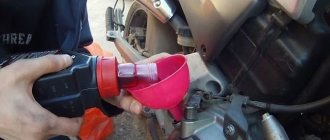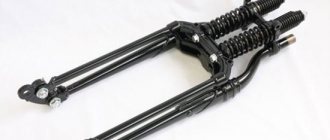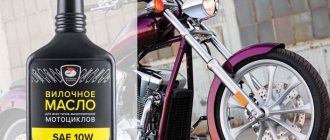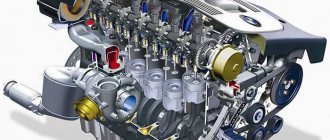Changing the engine oil
In 2-stroke technology, the oil does not change, but is regularly poured into a separate tank and supplied by an oil pump to the carburetor, where it is mixed with the air-gasoline mixture and supplied to the engine.
The mixture lubricates the rotating and rubbing parts of the engine, burns and exits with exhaust gases into the exhaust pipe.
Oil tanks on scooters have different volumes - from 0.6 l to 1.3 l.
One liter of oil is enough for about 1000 km.
If you ride a motorcycle every day, then five liters of oil will be enough for a 2-stroke engine for the summer season.
The Oil lamp on the instrument panel indicates that the oil has dropped to the reserve level.
If the lamp lights up, it means that there is little oil left in the tank.
You should not take risks and drive with the Oil light on, because as soon as the oil runs out completely, the engine will overheat and seize.
We'll have to capitalize on it. And this, you understand, is time-consuming and expensive repairs.
On 4-stroke 50 cc motorcycles, the oil is changed every 2 - 3 thousand km. During this mileage, fuel combustion substances accumulate in the oil and, as a result, it becomes dirty and thick, which changes its structure and properties.
If you drive together, transport cargo, that is, when the engine often works under heavy loads, then change the oil more often, after 1 - 1.5 thousand km.
Let's get down to business.
Start the scooter for 5 - 10 minutes. until the increased speed drops.
Place the motorcycle on the stand and turn off the engine.
Loosen the drain bolt.
Place a liter jar to drain the waste and unscrew the bolt completely.
Then unscrew the oil dipstick.
In 5 minutes, all the oil will flow out of the engine.
Qualitative indicators
The main technical characteristics of the Honda Dio are presented using the example of the AF 27 model:
| Parameters (length; width; height) | 167.5 cm; 63 cm; 99.5 cm |
| Weight | 69 kg |
| Speed | Maximum 60 km per hour |
| Tank volume (fuel; oil) | 5 l; 1.3 l |
| Load capacity | 150 kg |
| Engine | Two-stroke, variable speed with forced air cooling |
| Engine model | AF 34 E |
| Fuel consumption per 100 kilometers | 1.85 l |
| Engine capacity | 49.9 sq. cm |
| Start | Electric/kickstarter |
| Piston parameters (stroke; diameter) | 3.93 cm; 4 cm |
| Engine power | Maximum 7 horsepower (6500 rpm) |
| Chassis (brake; wheels) | Drum; 3.00-10 |
| Suspensions (front; rear) | Telescopic fork; spring shock absorber |
The entire range of Dio scooters has almost the same load capacity, speed, starting, two-stroke engine and suspension. Brakes may vary - some models have disc brakes on 1 or 2 wheels.
Test Drive
The Honda Dio scooter is undoubtedly endowed with considerable benefits and amenities that come in handy, especially for newly converted scooter riders. The main advantages of this vehicle include:
- speed allows you to be universal for any road;
- quite rigid frame;
- light weight, handling and excellent dynamics save the rider from unforeseen surprises;
- wear-resistant engine;
- ratio of quality and cost;
- perfect plastic, perfectly fitted at the joints;
- there is a 2nd passenger seat;
- dimensions;
- convenient trunk hidden under the seat;
- luggage hook;
- pocket immediately under the steering wheel;
- trendy design and streamlined shapes;
Photo of Honda Dio AF 34CESTA
More serious representatives, such as Dio AF 34 and 35 ZX, have the capabilities to participate in racing, and the memorable appearance will not leave any true connoisseur of motorcycle technology indifferent.
Models are found in restyling, in ABS modifications, which adds extra gas shock absorbers, crystal optics, a powerful engine and alloy wheels. Some are equipped with front baskets.
The AF 35 ZX model is amazingly good - this white beauty is simply mesmerizing during sharp starting jerks from traffic lights.
We detect inconveniences
Any thing in use by humanity is, as a rule, imperfect. Honda Dio scooters also have some disadvantages:
- due to high demand, difficulty in purchasing;
- not suitable for winter trips;
- rather expensive service station;
- low ground clearance (between the road and the frame);
- fans of scooter racing are not satisfied with the speed offered;
Repair instructions for Honda Dio
Tips for repairing Honda Dio are available to any motorcycle enthusiast. In particular, we will talk about servicing the vital parts of an iron car: engine, carburetor and transmission.
The carburetor is a sensitive and important part of the scooter. The slightest breakdown will stop the operation of the entire machine. Owners are often afraid to touch carburetors because they are not confident that they can assemble them correctly.
However, everything is not as scary as it seems at first glance. Honda Dio is recognized by experts as the most convenient and suitable representative for disassembling and cleaning the carburetor.
The fact that it is not covered with plastic, its location above the transmission and the ease of setting up the mechanism speak in its favor.
A few recommendations:
- the adjustment process is carried out on a well-warmed engine;
- if there is any doubt about a blockage, clean the carburetor and rinse thoroughly;
The setting itself involves adjustment:
- idle move;
- quality of the mixture (by moving the needle and using;
- specialized screw;
- amount of fuel in the float chamber;
Honda Dio engine repair
The engine is the heart of the scooter. Principles for eliminating basic breakdowns:
- piston wear and increasing fuel and lubricant consumption are caused by low compression (below 8.0 kg/cm3 with a norm of 9.5-10.5); it is necessary to bore or change the cylinder-piston group;
- a clear and loud knocking sound at the bottom of the cylinder, often when throttling, indicates wear of the piston skirt—replace the piston or the entire c/p group;
- the engine stalls, losing power, usually when it is clogged - cleaning is required: burn it, or cut it, clean off the carbon deposits and weld again; the exhaust window can be cleaned;
- does not start, does not work well, does not hold idle speed if the seals are broken (fuel leaks form there) of the cylinder, crankcase, head gasket, crankshaft seals are worn out - replace the seals and gaskets;
The transmission also becomes unusable, and, sooner or later, it is replaced. The process of replacing the variator is not particularly difficult. The main thing is to choose the right belt - this will allow you to keep its settings unchanged. For example, a very long belt will begin to slip, and a wide one will reduce the range of gear ratios and will not reach the maximum width of the cones.
Recommended variant belt sizes
| Models | Dimension in mm |
| AF18; SR AF25, 28; AF27, 34, 35; Fit AF27; XR AF27; | 15-650 |
| Smart Dio: AF56, DX AF57; Z4 AF57 | 17,7-670 |
| ZX AF28 | 18-662 |
| ZX AF35 | 18-667 |
Similar models
Yamaha JogSilver WingSpacyStels Vortex 50
Changing the oil in the gearbox
From our experience, we recommend using 75W90 oil; replacement should be done after 5 - 6 thousand km.
On all Suzuki and Yamaha models there is a drain bolt on the gearbox.
Place a wide bowl under it.
Unscrew two bolts: filler and drain.
Drain the waste - it will be 90 - 120 ml.
Tighten the drain bolt.
Place a tube on the syringe and pump oil into the gearbox to the level of the plug.
Tighten the filler bolt.
Therefore, drain the waste through the filler hole, tilting the scooter to one side.
To drain the waste, take a flat container or place an open plastic bag with a rag inside.
Then place the scooter on the stand and use a syringe with a tube attached to fill in the oil until it flows out.
Install the filler bolt and tighten slightly.
Working with the gearbox turned out to be even easier than working with the engine. Therefore, do not be afraid, try and service your motorcycle on time, at the required mileage, in order to ride longer without repairing the gearbox.
Subscribe to our blog. Don't miss the next article on carburetor cleaning and tuning.
Source
Honda Dio 27 (Honda Dio 27) - review of a reliable scooter for getting around the city
Scooters are a fairly convenient way of transportation for people who do not want to ride at prohibitive speeds. Such mopeds are usually bought by people who want to move quickly and comfortably in conditions of constant traffic jams and difficult traffic.
Also, scooters are chosen by those who are just starting to master two-wheeled technology, which is true in principle. But everything is evolving, and motorcycle manufacturers have learned to make scooters that can be compared with some cruiser or road motorcycle in terms of comfort and quality.
In today's review we will talk about the Honda Dio 27 scooter. Is this moped really as comfortable and reliable as they say it is?
Production of Honda Dio 27
The production of scooters in the “Dio” line began in 1988 and continued until 1992. Over the course of 4 years, the Japanese company managed to introduce several models from AF18 to AF25.
How to change engine oil on a scooter
We will talk about periodic maintenance of a four-stroke scooter, namely, changing the engine oil.
This mandatory point during the operation of the scooter cannot be underestimated, and the oil should be changed regularly. The operating principle of a four-stroke scooter engine was discussed here; as you know, unlike a two-stroke engine, the oil does not burn along with the fuel.
During the operation of the scooter, the production of engine parts in the form of metal dust settles in the engine oil, which changes the structure of the oil, and therefore its properties. In addition, low-quality motor oil may be characterized by sedimentation, changes in consistency over time, and other shortcomings that only have a detrimental effect on the scooter engine, and therefore shorten its trouble-free operation. In this regard, it is impossible to save on oil for a four-stroke scooter engine, since dubious savings will eventually result in expensive repairs. The same point applies to two-stroke engines and two-stroke oil, respectively.
Scooters Maintenance and repair
Often, when it is recommended to manually add oil to gasoline in a certain proportion when operating a two-stroke scooter, scooter owners cannot always quickly determine the required amount of oil, which can be poured directly into the tank or mixed in a canister.
This material will help you quickly understand the proportions and add the required amount of oil to a certain amount of gasoline in a matter of seconds without additional calculations.
When to add oil to gasoline
- The most important thing is that the scooter must be two-stroke. Mixing oil with gasoline for four-stroke engines is unacceptable!
- During the run-in period in very hot weather, to prevent the piston from jamming in the cylinder.
- If the oil pump malfunctions, when it cannot be adjusted, and operation of the scooter is urgently necessary.
- In the absence of an oil pump. Yes, this happens, especially when tuning. Scooter riders prefer to prepare a mixture of gasoline and oil on their own and pour the prepared mixture into the gas tank; in this case, of course, the oil pump is no longer needed and there is a plug instead.
- If the performance of the oil pump is insufficient after increasing the piston volume.
- Other cases.
How to choose NGK spark plugs. Selection by marking
How much oil should be added to gasoline
For example, a master can indicate the proportions after repair or tuning, when he knows the performance of the pump of a particular scooter and sets a certain proportion to replenish the missing amount of oil.
When running a two-stroke scooter, it is enough to add oil to gasoline at the rate of 1 to 30 with a fully functioning oil pump. You can find out more about this in the article:
- Running in a piston two-stroke scooter.
Now, actually, the table itself. Very simple and intuitive. The leftmost column is the number of liters of gasoline to which we will add oil.
In the header of the table we see the ratio that we need (1 to 20, 1 to 30, etc.). And in the body of the table we see the required amount of oil.
For example, during break-in, you need to add the required amount of oil at the rate of 1 to 30 to the five-liter gas tank of a Honda Dio scooter.
In the left column we select the number 5, in the top line we select the ratio 1/30, in the intersection we see the number 167. This is the amount of oil that we need, i.e. 167 ml.
Source: https://scooter-remont.com/?p=6398










